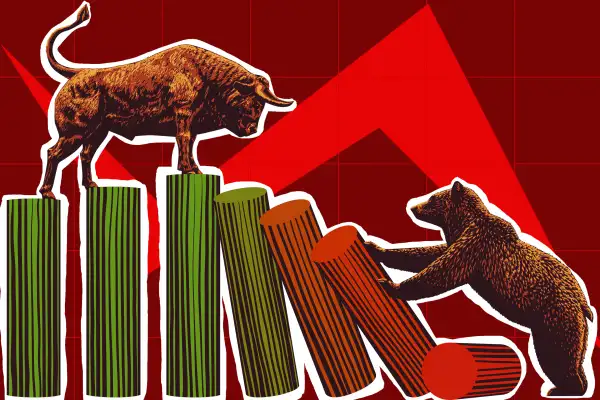3 Smart Investing Moves to Make in a Bear Market
Money is not a client of any investment adviser featured on this page. The information provided on this page is for educational purposes only and is not intended as investment advice. Money does not offer advisory services.

After a selloff that's lasted for months, it's official: Stocks are in a bear market.
It's the latest curve on the rollercoaster investors have been riding since the pandemic began. Financial markets plummeted in March of 2020 when COVID-19 hit the U.S., but quickly made a comeback, with the S&P 500 — a benchmark commonly used to measure the overall stock market — up 100% from that low by August of 2021.
But that was when the markets were enjoying the benefits of stimulus money from the government and near-zero interest rates, and those days appear to be over. To battle high inflation that's plaguing the economy, the Federal Reserve has already raised its benchmark interest rate twice this year and has started to reduce its balance sheet.
Now, the S&P 500 is down around 22% so far in 2022 and bitcoin's price has fallen more than 60% from its high of $68,000 in November.
"Seeing account balances down, the ups and downs of the market, and the news cycle coverage can make even the most iron-stomached investors nervous," Colleen O’Callaghan, a financial advisor at J.P. Morgan Wealth Management, tells Money via email.
That’s why it is important to identify your goals and stick to your long-term objectives, she adds.
As tempting as it may be to sell your investments in an attempt to avoid further losses, experts stress that it's very important to keep your money in the market during downturns. Other than that, it's often not clear what (if any) moves investors should make in a bear market. But below are some strategies you might want to consider.
What is a bear market?
A bear market is defined as a drop of 20% or more from the previous high for an index or even an individual stock.
When you hear experts refer to the stock market being in a bear market, they're usually talking about the S&P 500. More recently, you may hear people refer to the crypto bear market since the prices of bitcoin, ether, dogecoin and others have been plunging.
The S&P 500 officially entered a bear market on Monday when the index closed down 22% from its January high.
3 investing moves to make in a bear market
One thing you should definitely not do in a bear market is panic. But while the best move is often doing nothing at all, it can be scary to just watch your investing account balance sink.
So here are three moves to consider:
Rebalance
Long-term investors should not view market dips as a reason to make big changes to their investments, Anjali Jariwala, certified financial planner and founder of FIT Advisors, previously told Money. But investors could use this time to rebalance their portfolio to make sure their asset allocation still aligns with their risk tolerance and timeline.
Financial advisors tend to say that the key to long-term investing is having a diversified portfolio and regularly rebalancing. A diversified portfolio entails having a mix of stocks, bonds and cash, with the exact weightings based on your risk tolerance, goals and time horizon.
You also want to have diversification in terms of the stocks you own. That means a blend of domestic and international stocks and those in various sectors, like technology, industrials and health care. You don't want to just fill your portfolio with shares of the large companies you're familiar with; it's important to have small- and mid-cap stocks in there as well. Funds, like exchange-traded funds (ETFs) and mutual funds, are a good way to ensure you're not putting all your eggs in one basket, like you do when buying individual stocks.
Once you have your portfolio set, rebalancing regularly involves selling investments that have grown in value and replenishing those that have fallen in value to get your portfolio back to holding its target weights. It may be especially crucial to rebalance after a tumultuous few years, as some sectors, like technology, took off during the pandemic, and are now getting clobbered.
Not all financial assets perform well at the same time, Sean Williams, wealth advisor at Sojourn Wealth Advisory, told Money last month. Rebalancing regularly and having a diversified portfolio means that when one part of your portfolio tanks, another can hold up. It's up to you to decide how often you rebalance — some investors do it monthly, quarterly or annually. What's most important is that you do it regularly.
Put an investing plan in place
It may seem like now, when stocks are falling, would be too late to create a well-thought-out investing plan. But if you've been investing without discipline, or have been waiting for stocks to hit bottom so you can buy the dip, now may be a good time to form a plan you can stick to.
While it may be tempting to buy the dip, it's impossible to know what the markets will do next. really, really hard to time the market. Rather than attempting to time the market, investors should acknowledge the likelihood for markets to fall even further, Phillip Toews, CEO & co-portfolio manager for Toews Asset Management, tells Money via email. Investors may view this as a dip buying opportunity, but we could see another drop, he adds.
No one knows when stocks will hit bottom, or what any asset will do on a given day. That's why financial experts often recommend using a strategy like dollar-cost averaging, which entails regularly investing a set amount of money, like $100 every month.
That way you won't miss out on the market's best days because you're trying to guess when it's a good time to buy. Plus, then you (hopefully) won't stress out about every market fluctuation, because you'll know exactly when and how much you're going to invest next.
Now may be a good time to start investing or begin dollar-cost averaging, since you'll likely be able to benefit from the market's recovery.
Consider smart tax moves
Looking for a silver lining to this market downturn? Here's one: It might be a good time to convert your traditional individual retirement account (IRA) to a Roth IRA.
Traditional IRAs are tax-deferred, which means you fund it with pre-tax dollars and pay taxes on your withdrawals later in life. But a Roth IRA works oppositely in that you fund it with after-tax dollars. When you take out your money after age 59 1/2, those withdrawals are tax-free.
If you want to convert your IRA into a Roth IRA — and benefit from those tax-free withdrawals down the road — doing so when the value of your invested assets is lower could help you save on the taxes you'll have to pay on the conversion.
Of course, there are caveats, and this might not be the right move for you. You can find more by reading Money's recent story on converting a traditional IRA to a Roth IRA.
Another potential upside to seeing all this red in the market is you could potentially lower your tax bill with tax-loss harvesting.
When you sell a financial asset like stocks or cryptocurrency, you have to pay taxes on that profit. But with tax-loss harvesting, you sell an asset when its price is lower than the price you paid for it. You can then use that loss to offset gains, lowering your tax bill. The IRS allows taxpayers to offset up to $3,000 of ordinary income if your losses are bigger than your gains, and you can carry losses forward to future years if your loss is greater than that limit.
There are rules to keep in mind, like the wash-sale rule, which means you can't sell an investment when its price is down and immediately buy it — or one that is “substantially identical" — back. And it's not the right move for everyone; the benefit has to outweigh the risks. But in the long run, it's definitely possible to save on your taxes this way.
More from Money:
'Extreme Panic': 3 Reasons Why Bitcoin Is Plunging

